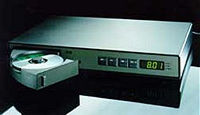| Columns Retired Columns & Blogs |
Naim CD 3.5 CD player
"Them which is of other naturs thinks different," said Martin Chuzzlewit's Mrs. Gamp. If that is true, then Naim's Julian Vereker must be of a very different nature indeed. Vereker—and, by extension, Naim—has never done things the conventional way. Take, for example, power regulation and stiffening power supplies. Long before the rest of the world was taking them seriously, Naim offered upgrades to their components not by changing the audio circuitry, but by adding stiffer and stiffer outboard power regulation.
 Their new "entry-level" CD player, the CD 3.5, follows in this tradition. It is a stand-alone CD player that offers an upgrade path. This, in itself, is not unusual—many companies offer a player that can be allied with a DAC when improved sound is desired. The CD 3.5, however, has no digital out—its upgrade path consists of an add-on outboard power supply, which powers the analog filters and output stages of the player. Different.
Their new "entry-level" CD player, the CD 3.5, follows in this tradition. It is a stand-alone CD player that offers an upgrade path. This, in itself, is not unusual—many companies offer a player that can be allied with a DAC when improved sound is desired. The CD 3.5, however, has no digital out—its upgrade path consists of an add-on outboard power supply, which powers the analog filters and output stages of the player. Different.
Internal difference is where the meanings are
The CD 3.5 doesn't look fancy. It's less than 3" tall and is 12" deep and 17" wide. Its case is metal, with a black crinkle finish, and its faceplate is sparsely populated. On the left is a hinged drawer, which the user must pull open by hand to load and empty the player. This drawer houses the transport mechanism, a Philips VAM 1205—a variant of the CDM12—and includes a Hall-Effect disc drive. A small magnetic "button" clamp is used to stabilize the CD in play. The only other adornments on the faceplate are four large buttons (Previous, Next, Stop, Play) and a small but readable display—which can be switched off. In contrast, the remote is small and rather cluttered.
The rear panel may look strange to anyone who's never examined a Naim component. In addition to a dedicated AC cable and a power switch, it has three DIN-style connectors. One of these connects the analog filters and output to the player's main board; if an outboard power supply is not used, a "link plug"—a small plastic paddle with shorting plugs—must be connected. Another connector accepts the output from an outboard power supply, while the last is the audio output. If the CD 3.5 is not used as part of a Naim system, DIN-to-RCA cables are available.
The CD 3.5 is based on the Philips CD7 part set. The servo controller chip is a Philips SAA7376, which controls all transport functions, transformation of the "eye pattern" FM signal into digital data, error correction, and digital filtering. Following this is a Philips TDA 1305 chip, which provides additional digital filtering and 18-bit D/A conversion.
A separate master clock controls all the primary digital functions, and the clock circuit's configuration is engineered to minimize jitter. A seven-pole analog filter follows the DAC to remove spurious noise.
The CD 3.5 has 14 low-noise regulated power supplies on the main board, and one more on the servo control board, which is mounted on the hinged tray. And, as I mentioned earlier, the player can be connected to any of Naim's external power supplies (ranging from the $700 FlatCap to the $4450 SuperCap), which power the analog circuitry separately. Naim claims this arrangement maintains signal integrity by keeping the DAC in the ideal position (ie, close to the data it must convert), while offering an upgrade path that doesn't compromise their design goals.
All main control functions are handled by a microprocessor running Naim-written software. Every aspect of the SAA7376 remains under software control, says Naim, which allows for improved performance. According to Julian Vereker, "There are 57 parameters that you can adjust with software—everything from the focusing to the speed of data coming off the disc to the time it takes to find tracks. Most players are quite crude in the way they find tracks. Ours, for example, reads the ToC [(Table of Contents)] in, and it can go directly to a given track without having to search repeatedly on its way, as do most players—ours gets there within a few microns. When you put a disc into the player, its parameters are checked and the player optimizes itself for that disc. This gives us a tremendous amount of control."
Another thing that sets the Naim apart from other players is its seven-pole analog filter. Vereker explained: "We found that digital filters in the early days weren't particularly accurate—nor are the cheaper modern ones. So we devised an active filter which bolts on the end of the digital filter and compensates for shortcomings in the digital filter—so the overall performance of the two together is a proper time-aligned filter."
- Log in or register to post comments



































